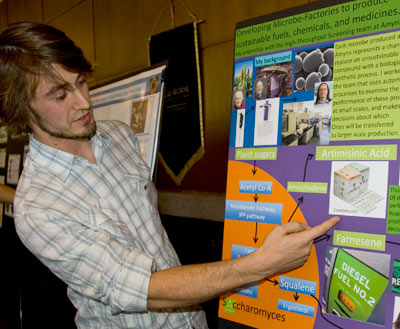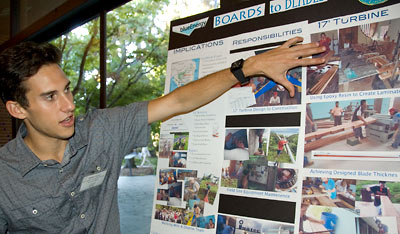Cal Energy Corps interns showcase research partnerships worldwide
The very first cohort of Cal Energy Corps student interns showcased an wide array of sustainable-energy research and service they conducted around the world this summer, at a Sept. 22 campus symposium. Their projects ranged from a low-tech food dehydrator, with a community on Nicaragua's Atlantic Coast, to advanced science to improve the formulation of new biofuels.
September 26, 2011
The Cal Energy Corps’ first student symposium fell 50 years to the day after Congress authorized the U.S. Peace Corps, from which the new UC Berkeley organization took inspiration. No one deliberately planned it that way, but once the coincidence was noted, it seemed fortuitous.
Not unlike generations of Peace Corps volunteers, the initial cohort of 19 Cal Energy Corps interns fanned out across the globe over the summer — this time to help research, develop and deploy sustainable-energy projects. Thursday’s event, held at Alumni House, was their first formal report-back on the summer’s challenges and revelations.

Max Schubert did biofuels research at Amyris. (Melani King photos)
The 19 undergrad scientists held paid internships in Denmark, Hong Kong, Taiwan, India, Nicaragua, Canada, Washington D.C. and Emeryville.
Max Schubert, who stayed closest to home, described his eight weeks at the East Bay biosciences firm Amyris, looking for ways to improve the biofuel Farnesene, manufactured from sugar cane. “Right now it’s running buses in Sao Paolo, Brazil,” he noted.
Schubert’s 300-member research team used high-tech instruments and automated processes to assay thousands of strains of yeast in search of desirable properties. He learned a lot, in the process, not only about biofuels but about what it takes to work in a commercial setting, as opposed to an academic research lab.
“The process is very much different than purely scientific investigation,” he wrote on the Cal Energy Corps Summer 2011 blog, “and fraught with challenges not purely of a technical nature, but of organization and communication.”
“There’s no way of learning that in the classroom,” he said Thursday.
In contrast, mechanical engineer David Olmos and environmental engineer Clayton Ernst spent their summers using low-tech tools in a remote location. The two were deployed to assist blueEnergy (a non-profit co-founded by a Cal alum) on Nicaragua’s Atlantic Coast — Olmos to work on a wind turbine, Ernst to fine-tune a food-dehydration device that locals can build themselves and use to boost their local economy.
Working to perfect the food-dryer design, Ernst tweaked its inclination, its convection ventilation system, and the color of its reflector. Changing the latter from black to red, he recounted, allowed the fruit to dry more slowly, rather than cook or carmelize in the sun. Ernst then left behind a 35-page set of plans, in Spanish, on how to construct a dehydrator.

David Olmos helped construct a wind turbine used to power a Nicaraguan health facility.
Olmos, meanwhile, led construction of wooden blades for a 17-foot wind turbine, used to generate energy to refrigerate vaccines and light a local community center.
“I hadn’t done much woodworking before,” he said — but the summer provided a crash course. Lacking a band saw, he and his local collaborators managed to make a rough cut out of cedro macho, a cedar wood native to the area, then use a machete and grinder to shape the blades.
As a finishing touch, Olmos painted the blades blue and gold, with a Cal bear stenciled on each.
Other Cal Energy Corps interns shared insights on thermoelectric, hybrid fuel, cook-stove, photovoltaic projects and more while interning at such organizations as the World Bank, the Chinese University of Hong Kong and Taiwan’s Academia Sinica.
In a keynote address introduced by VC for Research Graham Fleming, faculty member Ramesh Ramamoorthy — who currently directs the U.S. Department of Energy’s SunShot Initiative and the Solar Energy Technologies Program — described the agency’s efforts to make solar electricity available at a dollar a watt, without subsidies.
“We’re very good in U.S. at innovation,” he said, “but there’s much work to be done” to bring solar electricity, for instance, “all the way to manufacturing in the U.S.” He challenged Energy Corps interns to be part of that important effort.
The Cal Energy Corps plans to advertise its next round of paid internships in early December.